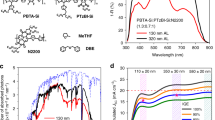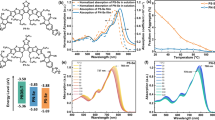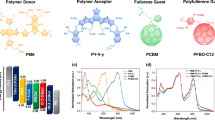Abstract
Recent advances in polymer solar cell (PSC) performance have resulted from compressing the bandgap to enhance the short-circuit current while lowering the highest occupied molecular orbital to increase the open-circuit voltage. Nevertheless, PSC power conversion efficiencies are still constrained by low fill factors, typically below 70%. Here, we report PSCs with exceptionally high fill factors by combining complementary materials design, synthesis, processing and device engineering strategies. The donor polymers, PTPD3T and PBTI3T, when incorporated into inverted bulk-heterojunction PSCs with a PC71BM acceptor, result in PSCs with fill factors of 76–80%. The enhanced performance is attributed to highly ordered, closely packed and properly oriented active-layer microstructures with optimal horizontal phase separation and vertical phase gradation. The result is efficient charge extraction and suppressed bulk and interfacial bimolecular recombination. The high fill factors yield power conversion efficiencies of up to 8.7% from polymers with suboptimal bandgaps, suggesting that efficiencies above 10% should be realizable by bandgap modification.
This is a preview of subscription content, access via your institution
Access options
Subscribe to this journal
Receive 12 print issues and online access
$209.00 per year
only $17.42 per issue
Buy this article
- Purchase on Springer Link
- Instant access to full article PDF
Prices may be subject to local taxes which are calculated during checkout





Similar content being viewed by others
References
Yu, G., Gao, J., Hummelen, J. C., Wudl, F. & Heeger, A. J. Polymer photovoltaic cells: enhanced efficiencies via a network of internal donor–acceptor heterojunctions. Science 270, 1789–1791 (1995).
Cheng, Y-J., Yang, S-H. & Hsu, C-S. Synthesis of conjugated polymers for organic solar cell applications. Chem. Rev. 109, 5868–5923 (2009).
He, Z. et al. Simultaneous enhancement of open-circuit voltage, short-circuit current density, and fill factor in polymer solar cells. Adv. Mater. 23, 4636–4643 (2011).
He, Z. C. et al. Enhanced power-conversion efficiency in polymer solar cells using an inverted device structure. Nature Photon. 6, 591–595 (2012).
Green, M. A., Emery, K., Hishikawa, Y., Warta, W. & Dunlop, E. D. Solar cell efficiency tables (version 40). Prog. Photovolt. 20, 606–614 (2012).
Scharber, M. C. et al. Design rules for donors in bulk-heterojunction solar cells—towards 10% energy-conversion efficiency. Adv. Mater. 18, 789–794 (2006).
Mihailetchi, V. D., Xie, H. X., de Boer, B., Koster, L. J. A. & Blom, P. W. M. Charge transport and photocurrent generation in poly(3-hexylthiophene):methanofullerene bulk-heterojunction solar cells. Adv. Funct. Mater. 16, 699–708 (2006).
Wagner, J. et al. High fill factor and open circuit voltage in organic photovoltaic cells with diindenoperylene as donor material. Adv. Funct. Mater. 20, 4295–4303 (2010).
Li, G., Zhu, R. & Yang, Y. Polymer solar cells. Nature Photon. 6, 153–161 (2012).
Clarke, T. M. et al. Charge carrier mobility, bimolecular recombination and trapping in polycarbazole copolymer:fullerene (PCDTBT:PCBM) bulk heterojunction solar cells. Org. Electron. 13, 2639–2646 (2012).
Shuttle, C. G., Hamilton, R., O'Regan, B. C., Nelson, J. & Durrant, J. R. Charge-density-based analysis of the current–voltage response of polythiophene/fullerene photovoltaic devices. Proc. Natl Acad. Sci. USA 107, 16448–16452 (2010).
Zhang, Y., Dang, X. D., Kim, C. & Nguyen, T. Q. Effect of charge recombination on the fill factor of small molecule bulk heterojunction solar cells. Adv. Energy Mater. 1, 610–617 (2011).
Cowan, S. R., Banerji, N., Leong, W. L. & Heeger, A. J. Charge formation, recombination, and sweep-out dynamics in organic solar cells. Adv. Funct. Mater. 22, 1116–1128 (2012).
Kirchartz, T., Pieters, B. E., Kirkpatrick, J., Rau, U. & Nelson, J. Recombination via tail states in polythiophene: fullerene solar cells. Phys. Rev. B 83, 115209 (2011).
Cowan, S. R., Roy, A. & Heeger, A. J. Recombination in polymer-fullerene bulk heterojunction solar cells. Phys. Rev. B 82, 245207 (2010).
Koster, L. J. A., Mihailetchi, V. D., Ramaker, R. & Blom, P. W. M. Light intensity dependence of open-circuit voltage of polymer:fullerene solar cells. Appl. Phys. Lett. 86, 123509 (2005).
Shuttle, C. G. et al. Bimolecular recombination losses in polythiophene: fullerene solar cells. Phys. Rev. B 78, 113201 (2008).
Credgington, D., Hamilton, R., Atienzar, P., Nelson, J. & Durrant, J. R. Non-geminate recombination as the primary determinant of open-circuit voltage in polythiophene:fullerene blend solar cells: an analysis of the influence of device processing conditions. Adv. Funct. Mater. 21, 2744–2753 (2011).
Street, R. A., Schoendorf, M., Roy, A. & Lee, J. H. Interface state recombination in organic solar cells. Phys. Rev. B 81, 205307 (2010).
Mauer, R., Howard, I. A. & Laquai, F. Effect of nongeminate recombination on fill factor in polythiophene/methanofullerene organic solar cells. J. Phys. Chem. Lett. 1, 3500–3505 (2010).
Mauer, R., Howard, I. A. & Laquai, F. Effect of external bias on nongeminate recombination in polythiophene/methanofullerene organic solar cells. J. Phys. Chem. Lett. 2, 1736–1741 (2011).
Proctor, C. M., Kim, C., Neher, D. & Nguyen, T-Q. Nongeminate recombination and charge transport limitations in diketopyrrolopyrrole-based solution-processed small molecule solar cells. Adv. Funct. Mater. http://dx.doi.org/10.1002/adfm.201202643.
Green, M. A. Solar-cell fill factors: general graph and empirical expressions. Solid-State Electron. 24, 788–789 (1981).
Kippelen, B. & Bredas, J. L. Organic photovoltaics. Energy Environ. Sci. 2, 251–261 (2009).
Zhao, J., Wang, A. & Green, M. A. 24.5% efficiency silicon PERT cells on MCZ substrates and 24.7% efficiency PERL cells on FZ substrates. Prog. Photovolt. 7, 471–474 (1999).
McCulloch, I. et al. Semiconducting thienothiophene copolymers: design, synthesis, morphology, and performance in thin-film organic transistors. Adv. Mater. 21, 1091–1109 (2009).
Guo, X. et al. Bithiopheneimide-dithienosilole/dithienogermole copolymers for efficient solar cells: information from structure–property–device performance correlations and comparison to thieno[3,4-c]pyrrole-4,6-dione analogues. J. Am. Chem. Soc. 134, 18427–18439 (2012).
Ko, S. et al. Controlled conjugated backbone twisting for an increased open-circuit voltage while having a high short-circuit current in poly(hexylthiophene) derivatives. J. Am. Chem. Soc. 134, 5222–5232 (2012).
Dimitrov, S. D. et al. On the energetic dependence of charge separation in low-band-gap polymer/fullerene blends. J. Am. Chem. Soc. 134, 18189–18192 (2012).
Bakulin, A. A. et al. The role of driving energy and delocalized states for charge separation in organic semiconductors. Science 335, 1340–1344 (2012).
Chabinyc, M. L. X-ray scattering from films of semiconducting polymers. Polym. Rev. 48, 463–492 (2008).
Szarko, J. M. et al. When function follows form: effects of donor copolymer side chains on film morphology and BHJ solar cell performance. Adv. Mater. 22, 5468–5472 (2010).
Chou, C. H., Kwan, W. L., Hong, Z., Chen, L. M. & Yang, Y. A metal-oxide interconnection layer for polymer tandem solar cells with an inverted architecture. Adv. Mater. 23, 1282–1286 (2011).
Peet, J., Heeger, A. J. & Bazan, G. C. ‘Plastic’ solar cells: self-assembly of bulk heterojunction nanomaterials by spontaneous phase separation. Acc. Chem. Res. 42, 1700–1708 (2009).
Rivnay, J. et al. Drastic control of texture in a high performance n-type polymeric semiconductor and implications for charge transport. Macromolecules 44, 5246–5255 (2011).
Lilliu, S. et al. Dynamics of crystallization and disorder during annealing of P3HT/PCBM bulk heterojunctions. Macromolecules 44, 2725–2734 (2011).
Rogers, J. T., Schmidt, K., Toney, M. F., Kramer, E. J. & Bazan, G. C. Structural order in bulk heterojunction films prepared with solvent additives. Adv. Mater. 23, 2284–2288 (2011).
Piliego, C. et al. Synthetic control of structural order in N-alkylthieno[3,4-c]pyrrole-4,6-dione-based polymers for efficient solar cells. J. Am. Chem. Soc. 132, 7595–7597 (2010).
Osaka, I. et al. Synthesis, characterization, and transistor and solar cell applications of a naphthobisthiadiazole-based semiconducting polymer. J. Am. Chem. Soc. 134, 3498–3507 (2012).
Peet, J. et al. Efficiency enhancement in low-bandgap polymer solar cells by processing with alkane dithiols. Nature Mater. 6, 497–500 (2007).
Tada, A., Geng, Y., Wei, Q., Hashimoto, K. & Tajima, K. Tailoring organic heterojunction interfaces in bilayer polymer photovoltaic devices. Nature Mater. 10, 450–455 (2011).
Bjorstrom, C. M. et al. Vertical phase separation in spin-coated films of a low bandgap polyfluorene/PCBM blend: effects of specific substrate interaction. Appl. Surf. Sci. 253, 3906–3912 (2007).
Wobkenberg, P. H. et al. Low-voltage organic transistors based on solution processed semiconductors and self-assembled monolayer gate dielectrics. Appl. Phys. Lett. 93, 013303 (2008).
Bronstein, H. et al. Thieno[3,2-b]thiophene-diketopyrrolopyrrole-containing polymers for high-performance organic field-effect transistors and organic photovoltaic devices. J. Am. Chem. Soc. 133, 3272–3275 (2011).
Parmer, J. E. et al. Organic bulk heterojunction solar cells using poly(2,5-bis(3-tetradecyllthiophen-2-yl)thieno[3,2,-b]thiophene). Appl. Phys. Lett. 92, 113309 (2008).
Shuttle, C. G. et al. Charge extraction analysis of charge carrier densities in a polythiophene/fullerene solar cell: analysis of the origin of the device dark current. Appl. Phys. Lett. 93, 183501 (2008).
Maurano, A. et al. Recombination dynamics as a key determinant of open circuit voltage in organic bulk heterojunction solar cells: a comparison of four different donor polymers. Adv. Mater. 22, 4987–4992 (2010).
Li, Z., Gao, F., Greenham, N. C. & McNeill, C. R. Comparison of the operation of polymer/fullerene, polymer/polymer, and polymer/nanocrystal solar cells: a transient photocurrent and photovoltage study. Adv. Funct. Mater. 21, 1419–1431 (2011).
Mandoc, M. M., Kooistra, F. B., Hummelen, J. C., de Boer, B. & Blom, P. W. M. Effect of traps on the performance of bulk heterojunction organic solar cells. Appl. Phys. Lett. 91, 263505 (2007).
McArthur, E. A., Morris-Cohen, A. J., Knowles, K. E. & Weiss, E. A. Charge carrier resolved relaxation of the first excitonic state in CdSe quantum dots probed with near-infrared transient absorption spectroscopy. J. Phys. Chem. B 114, 14514–14520 (2010).
Acknowledgements
This research was supported as part of the ANSER Center, an Energy Frontier Research Center funded by the US Department of Energy, Office of Science, and Office of Basic Energy Sciences (award no. DE-SC0001059), by Polyera Corporation, and by AFOSR (FA9550-08-1-0331). The authors acknowledge the NSF-MRSEC programme of the Northwestern University Materials Research Science and Engineering Center for characterization facilities (DMR-1121262) and the Institute for Sustainability and Energy at Northwestern (ISEN) for partial funding for equipment. The microscopy work was performed in the EPIC facility of the NUANCE Center at Northwestern University, which is supported by NSF-NSEC, NSF-MRSEC, the Keck Foundation, the State of Illinois and Northwestern University. X.G. acknowledges financial support from an SUSTC start-up fund. Use of the Advanced Photon Source was supported by the US Department of Energy, Office of Science, Office of Basic Energy Sciences (contract no. DE-AC02-06CH11357). R.P.O. acknowledges the MICINN of Spain for a Ramòn y Cajal research contract. J.T.L.N. acknowledges financial support from the MICINN (project no. CTQ2012-33733) and the Junta de Andalucía (project no. PO9-4708). D.B.T. is funded by the NSF-IGERT Program.
Author information
Authors and Affiliations
Contributions
X.G. designed and performed materials synthesis and characterization. N.Z. fabricated the solar cell device and characterized the film morphology using XRD, AFM, TEM and XPS. S.J.L. and J.St. performed two-dimensional GIWAXS film characterization. J.W.H. (OFET) and J.Sm. (SCLC) characterized charge carrier mobility. R.P.O. and J.T.L.N. performed DFT calculations. N.Z. and S.L. characterized the film morphology by cross-sectional TEM. N.Z., J.Sm. and D.B.T. carried out transient photovoltage and photocurrent measurements. X.G., N.Z. and T.J.M. prepared the manuscript. All authors discussed the results and commented on the manuscript. L.X.C., R.P.H.C., A.F. and T.J.M. supervised the project.
Corresponding authors
Ethics declarations
Competing interests
The authors declare no competing financial interests.
Supplementary information
Supplementary information
Supplementary information (PDF 2230 kb)
Rights and permissions
About this article
Cite this article
Guo, X., Zhou, N., Lou, S. et al. Polymer solar cells with enhanced fill factors. Nature Photon 7, 825–833 (2013). https://doi.org/10.1038/nphoton.2013.207
Received:
Accepted:
Published:
Issue Date:
DOI: https://doi.org/10.1038/nphoton.2013.207
This article is cited by
-
Performance optimization of active layer doped P3HT:PCBM nanoparticles for organic photovoltaic cell applications
Journal of Nanoparticle Research (2023)
-
Computational Study of New Small Molecules based Thiophene as Donor Materials for Bulk Heterojunction Photovoltaic Cells
Journal of Fluorescence (2023)
-
Electronic structure and photophysical properties of some promising organic molecules for organic solar cells
Journal of Molecular Modeling (2023)
-
Hierarchical phase separation in all small-molecule organic solar cells
Journal of Nanoparticle Research (2022)
-
A review on high performance photovoltaic cells and strategies for improving their efficiency
Frontiers in Energy (2022)



